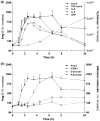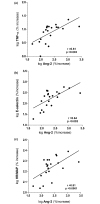Time course of angiopoietin-2 release during experimental human endotoxemia and sepsis
- PMID: 19416526
- PMCID: PMC2717419
- DOI: 10.1186/cc7866
Time course of angiopoietin-2 release during experimental human endotoxemia and sepsis
Abstract
Introduction: Endothelial activation leading to vascular barrier breakdown denotes a devastating event in sepsis. Angiopoietin (Ang)-2, a circulating antagonistic ligand of the endothelial specific Tie2 receptor, is rapidly released from Weibel-Palade and has been identified as a non-redundant gatekeeper of endothelial activation. We aimed to study: the time course of Ang-2 release during human experimental endotoxemia; the association of Ang-2 with soluble adhesion molecules and inflammatory cytokines; and the early time course of Ang-2 release during sepsis in critically ill patients.
Methods: In 22 healthy volunteers during a 24-hour period after a single intravenous injection of lipopolysaccharide (LPS; 4 ng/kg) the following measurement were taken by immuno luminometric assay (ILMA), ELISA, and bead-based multiplex technology: circulating Ang-1, Ang-2, soluble Tie2 receptor, the inflammatory molecules TNF-alpha, IL-6, IL-8 and C-reactive protein, and the soluble endothelial adhesion molecules inter-cellular adhesion molecule-1 (ICAM-1), E-selectin, and P-selectin. A single oral dose of placebo or the p38 mitogen activated protein (MAP) kinase inhibitor drug, RWJ-67657, was administered 30 minutes before the endotoxin infusion. In addition, the course of circulating Ang-2 was analyzed in 21 septic patients at intensive care unit (ICU) admission and after 24 and 72 hours, respectively.
Results: During endotoxemia, circulating Ang-2 levels were significantly elevated, reaching peak levels 4.5 hours after LPS infusion. Ang-2 exhibited a kinetic profile similar to early pro-inflammatory cytokines TNF-alpha, IL-6, and IL-8. Ang-2 levels peaked prior to soluble endothelial-specific adhesion molecules. Finally, Ang-2 correlated with TNF-alpha levels (r = 0.61, P = 0.003), soluble E-selectin levels (r = 0.64, P < 0.002), and the heart rate/mean arterial pressure index (r = 0.75, P < 0.0001). In septic patients, Ang-2 increased in non-survivors only, and was significantly higher compared with survivors at baseline, 24 hours, and 72 hours.
Conclusions: LPS is a triggering factor for Ang-2 release in men. Circulating Ang-2 appears in the systemic circulation during experimental human endotoxemia in a distinctive temporal sequence and correlates with TNF-alpha and E-selectin levels. In addition, not only higher baseline Ang-2 concentrations, but also a persistent increase in Ang-2 during the early course identifies septic patients with unfavorable outcome.
Figures



References
-
- Fiedler U, Krissl T, Koidl S, Weiss C, Koblizek T, Deutsch U, Martiny-Baron G, Marme D, Augustin HG. Angiopoietin-1 and angiopoietin-2 share the same binding domains in the Tie-2 receptor involving the first Ig-like loop and the epidermal growth factor-like repeats. J Biol Chem. 2003;278:1721–1727. doi: 10.1074/jbc.M208550200. - DOI - PubMed
Publication types
MeSH terms
Substances
LinkOut - more resources
Full Text Sources
Other Literature Sources
Medical
Research Materials
Miscellaneous

